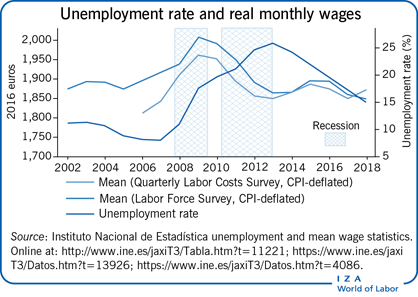Elevator pitch
Spain, the fourth largest eurozone economy, was hit particularly hard by the Great Recession, which made its chronic labor market problems more evident. Youth and long-term unemployment escalated during the crisis and, despite the ongoing recovery, in 2018 were still at very high levels. The aggregate rate of temporary employment declined during the recession, but grew among youth. Most interesting have been the narrowing of the gender gap in labor force participation, the decline in the share of immigrants in employment and the labor force, and the overall increase in wage inequality.

Key findings
Pros
Employment has grown at an average annual rate of 2.4% since 2014.
The gender gaps in labor force participation and temporary employment were smaller in 2018 than before the recession.
The overall rate of temporary employment decreased in the wake of the Great Recession.
The share of immigrant employment started growing again after 2014, albeit slowly.
Both overall monthly wage inequality and inequality in the lower half of the monthly wage distribution started decreasing slowly in 2013.
Cons
Youth and long-term unemployment skyrocketed during the Great Recession; in 2018 they were still both very high and very far from their pre-crisis levels.
Male labor force participation fell because of the drastic reduction in young men’s participation in the aftermath of the crisis.
The rate of temporary employment escalated significantly among youth.
Immigrants were hit particularly hard by the Great Recession.
Real wages declined during the recession and have not returned yet to their pre-recession levels; this decline was especially pronounced for low-wage workers.